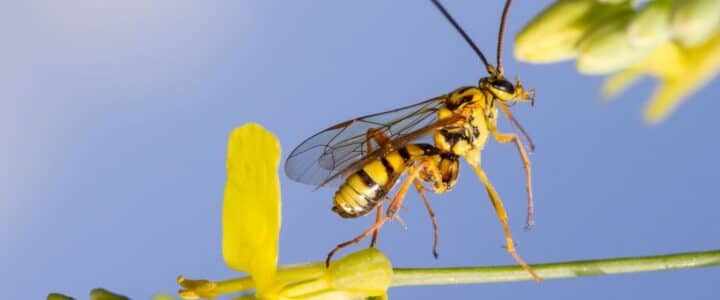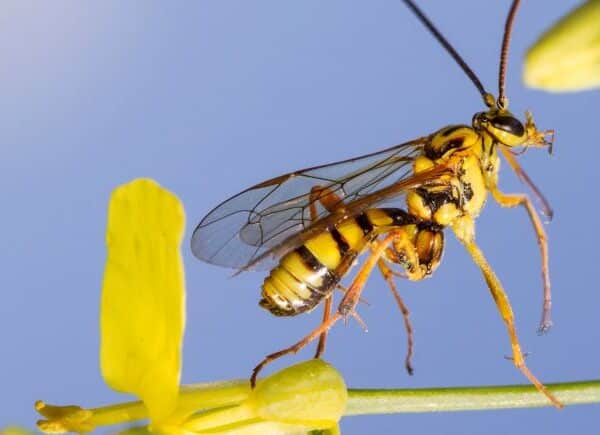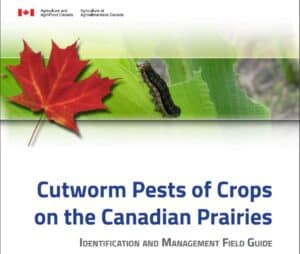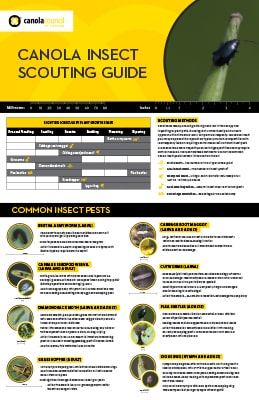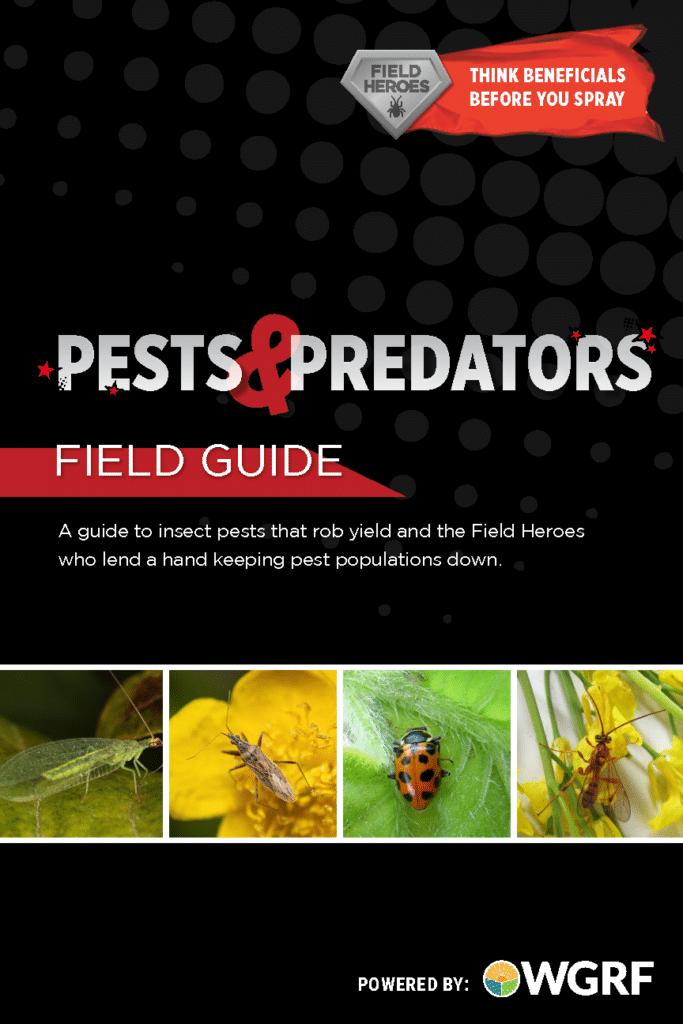Photo credit: Shelley Barkley
With many tasks and considerations on the go during the growing season, including scouting and counting insects in multiple spots within a field, time to observe minute details on individual insects may not be a reasonable option. So taking the opportunity outside of the growing season to familiarize yourself with a few biocontrol organisms that might be in your canola field, or could be an optional control in the coming years, will make it easier to potentially spot them next year. This blog investigates some nematodes, wasp parasitoids and other insect pest predators as biocontrol options to impact cutworm (and other insect pest) populations in your crop.
Quantifying biocontrol efficacy with predatory nematodes
One potential biocontrol option is entomopathogenic nematodes (or EPNs). These predatory nematodes are soil-dwelling round worms that specialize in parasitizing insects, including canola pest species. Limited research has been completed on the use of EPNs to control foliar and below ground insect pests in the Canadian Prairies. So Paul Tiege and Shabeg Briar investigated the possibility of EPNs as a commercially available biocontrol agent in the Biocontrol potential of entomopathogenic nematodes (EPNs) against selected key insect pests of canola in Alberta project.
They examined the juvenile stage of four different commercially available EPN species (Heterorhabditis bacteriophora, Steinernema carpocapsae, S. kraussei and S. feltiae) at different application rates (concentrations) against foliar pest insects (flea beetles, diamondback moth larvae and lygus bugs) using Petri dishes and below ground pests (including cabbage root maggots and black cutworms) using sandy soil in plastic cups, under controlled laboratory conditions. Insect mortality was assessed after 72 hours of exposure to the nematodes and observed under the microscope to confirm nematode infection.
Apply this research on your farm
- When scouting field for insects, have an extra look for parasitized pest insects. Report unusual insects noticed to PPMN.
- Learn all the beneficial insects in the Field Heroes Guide and CCC insect scouting guide & share with your grower/agronomist.
- Review the Cutworms on the Canadian Prairies before the growing season starts.
- Listen to this Canola Watch podcast Prairie Pest Monitoring Network (PPMN).
- Read this and other 2022 Canola Digest: Science Edition articles.
Results
In general, mortality rates of most insects increased with increasing nematode concentrations. Specific impacts of the species varied by insect pest species.
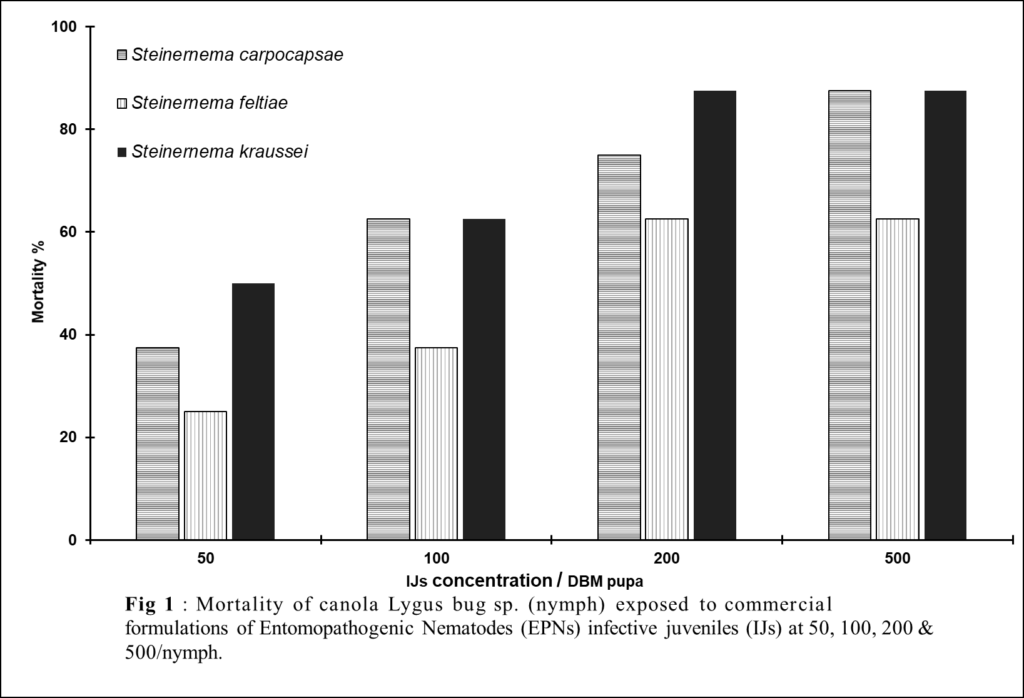
Foliar pest insects:
- Diamondback moth: Mortality rates for larval diamondback moth ranged from 33-63 per cent at low nematode concentrations and 60-90 per cent at high concentrations. Mortality of diamondback moth pupae was generally lower than larvae, with rates across species ranging from 30-40 per cent at low nematode concentrations to 50-70 per cent at high nematode concentrations.
- Lygus bugs: Mortality rates for lygus bugs were 39-50 per cent at low nematode concentrations and 62-87 per cent at higher concentrations.
- Flea beetles: Unfortunately, very low mortality rates (10 per cent or less) were reported for adult flea beetles, even at the highest concentration of nematodes.
Below ground pest insects:
- Black cutworm larvae: Mortality rates for black cutworms were 10-80 per cent for low nematode concentrations, 85-100 per cent for high concentrations.
- Cabbage root maggots: Two nematode species resulted in no to low mortality to cabbage root maggot larvae, at any concentrations. The other two species produced progressively higher mortality rates with increasing nematode concentrations, ranging from 8-17 per cent at low concentrations and up to 83 per cent at high concentrations. Pupal stage of root maggots appeared to be resistant to all EPN species and showed no host penetration of the pupal stage.
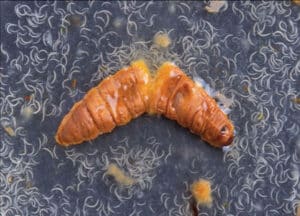
Subsequent EPN research
This study provided encouraging base line laboratory information with commercially available EPN species on canola for management of multiple insect pests including diamondback moth larvae, lygus bugs cabbage root maggots and black cutworms. Exploration of locally adapted and virulent strains of EPNs pertinent to the Prairies should also be considered in the future projects. Investigating the effectiveness of selected EPN species outside laboratory environment under greenhouse and field conditions would also be interesting.
Though efficacy (mortality) of flea beetles varied among the EPN species, further exploration on applications of EPNs targeting flea beetle overwintering sites appears could be considered, with the aim of reduction in adult flea beetle populations migrating to the neighbouring fields.
Parasitism of cutworms
The patchy distribution and subterranean habitat from which cutworms emerge at night to feed on young plants at or below the soil surface make chemical control of this insect pest challenging. Since the spring stem feeding of multiple cutworm species on several major Canadian crops can cause enough damage to warrant reseeding, additional control options, such as biological control by natural enemies required investigation.

Sharanowski and Lawley’s ‘Biocontrol of canola cutworms: Identification and attraction of parasitoids’ project examined Hymenoptera (the insect order to which wasps, bees, ants and sawflies belong) parasitoids that attacked economically important cutworms in Canada.
Sixteen parasitoid species attacking cutworms
Key findings from this research includes:
- Sixteen different species of hymenopteran parasitoids were found attacking cutworms in the Canadian Prairies.
- Parasitism rates ranged from 3-26%, with the highest parasitism rates found in Alberta and low rates were found in Manitoba.
- The rate of parasitism was often too low to reduce cutworms below economic levels.
- Relative flowing periods and durations for each cover crop plant species were examined and, noting that growing cover crop mixtures extends flowering period, it was suggested that it would be possible to design cover crop mixtures to compliment the life cycles of known parasitoids, such as Copidosoma cuproviridis.
- While C. cuproviridis adults emerging from field-collected cutworms from early July to early August showed that the canola flowering period coincides with the reproductive period of C. cuproviridis, this parasitoid was found to be less attracted to mustard and canola compared to camelina. It was also noted that an additional summer flowering Brassicaceae could lead to increased attraction of late season canola pests, which may negate the benefits of cutworm control for the next season.
- Therefore, it was decided that further studies are needed before camelina can be recommended as a habitat management tool for maximizing parasitism of cutworms.
- While C. cuproviridis adults emerging from field-collected cutworms from early July to early August showed that the canola flowering period coincides with the reproductive period of C. cuproviridis, this parasitoid was found to be less attracted to mustard and canola compared to camelina. It was also noted that an additional summer flowering Brassicaceae could lead to increased attraction of late season canola pests, which may negate the benefits of cutworm control for the next season.
- A cutworm identification key was developed as a tool for researchers to identify all sixteen species of parasitoids found attacking cutworms in the Canadian Prairies.
Potential of entomopathogenic fungi for biocontrol

Percentage of dead cutworms due to different mortality factors by year. All other cutworms collected for the study lived to form adult moths.
Within this project, an additional study was completed on assessing the efficacy of entomopathogenic fungi (EPF) as biocontrol agents of cutworms. EPF are environmentally friendly pest control agents that naturally occur in the soil. Few studies have examined the potential for EPF to control cutworms, and thus there is limited documentation of EPF attacking economically important cutworms in Canada and EPFs have been underutilized as biological agents for cutworm management.
According to our 2012-2014 cutworm data in Manitoba, EPF caused greater mortality to cutworms than parasitoids. Therefore, they could be more suitable biocontrol agent than parasitic wasps in Manitoba, and possibly in other Prairie provinces.
Future research on this topic could investigate potential interactions between pre-emergence herbicides and EPF in field crops (especially to determine any impact of herbicides on the efficacy of EPF applications, since EPF would need to be applied in the early seedling stage when cutworms cause damage, which is also potentially right after fields are treated with herbicides).
Cutworm identification and parasitoid discovery
Further investigating cutworm control options, Kevin Floate’s five-year ‘Detection, Identification and control strategies for management of cutworms (Noctuidae) on the prairie provinces’ project aimed to:
- Develop molecular tools for identification of cutworms.
- Learn about natural enemies of cutworms in different crops and their role in control.
- Develop tools and information to improve monitoring of cutworm species and their control.
- Develop extension tools for agronomists and producers.
In addition to achieving the objectives, Key findings from this include:
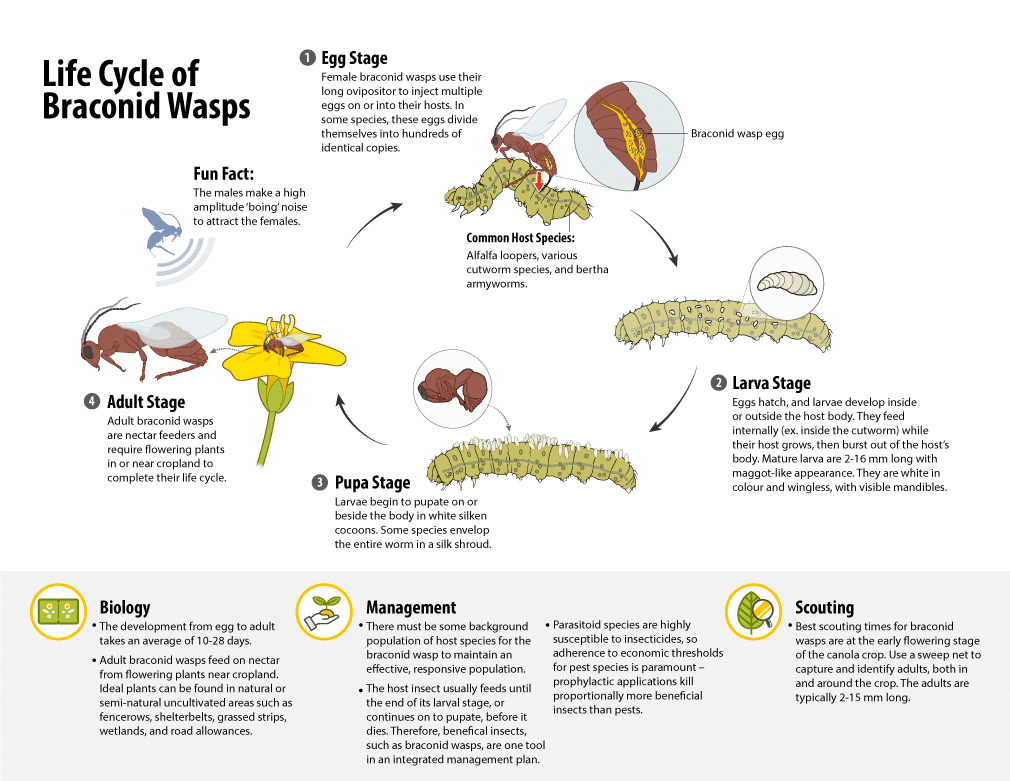
- The development of a DNA protocol for quick, accurate identification of cutworm species.
- Determining that parasitoids can provide a natural reduction in the severity and duration of cutworm outbreaks.
- At least three species of fly and 13 species of wasp parasitoids were collected in Alberta over three years (2012-2014), during which parasitism averaged about 20 per cent, based on year and collection site.
- A European species of parasitic wasp (Cotesia vanessae) was discovered in North America for the first time during this research.
- Laboratory tests proved that this wasp has potential to develop on 34 (of 47 tested) species of caterpillars, including many of the cutworm species that affect Canadian crops (and potentially delay or reduce the severity of future cutworm outbreaks).
- Fertilizer use was associated with increased oviposition by bertha armyworm on canola and also increased larval development time and weight.
- Larval development of both redbacked and pale western cutworms was quicker on fertilized plants compared to non-fertilized plants, regardless of the host crop.
- Bertha armyworm moths also laid more eggs on plants grown with increasingly higher levels of fertilizer.
- Floate, worked in collaboration with Erl Svendsen to completed a 100-page, richly-illustrated Cutworm Pests of Crops on the Canadian Prairie: Identification and Management Field Guide which provides identification and control information of 20 cutworm pest species.
Resources and opportunities

Published December 23, 2022


